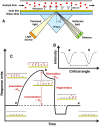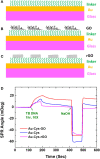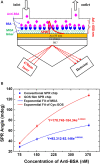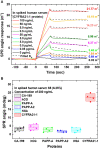Exploring Graphene and MoS2 Chips Based Surface Plasmon Resonance Biosensors for Diagnostic Applications
- PMID: 33005604
- PMCID: PMC7479841
- DOI: 10.3389/fchem.2020.00728
Exploring Graphene and MoS2 Chips Based Surface Plasmon Resonance Biosensors for Diagnostic Applications
Abstract
Until now, two-dimensional (2D) nanomaterials have been widely studied and applied in the biosensor field. Some of the advantages offered by these 2D materials include large specific surface area, high conductivity, and easy surface modification. This review discusses the use of 2D material in surface plasmon resonance (SPR) biosensor for diagnostic applications. Two-dimensional material reviewed includes graphene and molybdenum disulfide (MoS2). The discussion begins with a brief introduction to the general principles of the SPR biosensor. The discussion continues by explaining the properties and characteristics of each material and its effect on the performance of the SPR biosensor, in particular its sensitivity. This review concludes with some recent applications of graphene- and MoS2-based SPR biosensor in diagnostic applications.
Keywords: 2D materials; MoS2; biosensor; diagnostic; graphene; surface plasmon resonance.
Copyright © 2020 Nurrohman, Wang and Chiu.
Figures















Similar articles
-
Immunoassay-Amplified Responses Using a Functionalized MoS2-Based SPR Biosensor to Detect PAPP-A2 in Maternal Serum Samples to Screen for Fetal Down's Syndrome.Int J Nanomedicine. 2021 Apr 9;16:2715-2733. doi: 10.2147/IJN.S296406. eCollection 2021. Int J Nanomedicine. 2021. PMID: 33859474 Free PMC article.
-
A Review of Graphene-Based Surface Plasmon Resonance and Surface-Enhanced Raman Scattering Biosensors: Current Status and Future Prospects.Nanomaterials (Basel). 2021 Jan 15;11(1):216. doi: 10.3390/nano11010216. Nanomaterials (Basel). 2021. PMID: 33467669 Free PMC article. Review.
-
Affinity capture surface carboxyl-functionalized MoS2 sheets to enhance the sensitivity of surface plasmon resonance immunosensors.Talanta. 2018 Aug 1;185:174-181. doi: 10.1016/j.talanta.2018.03.073. Epub 2018 Mar 27. Talanta. 2018. PMID: 29759186
-
Surface plasmon resonance biosensor chips integrated with MoS2-MoO3 hybrid microflowers for rapid CFP-10 tuberculosis detection.J Mater Chem B. 2023 Dec 13;11(48):11588-11599. doi: 10.1039/d3tb01327h. J Mater Chem B. 2023. PMID: 38018444
-
Biomedical Applications of an Ultra-Sensitive Surface Plasmon Resonance Biosensor Based on Smart MXene Quantum Dots (SMQDs).Biosensors (Basel). 2022 Sep 9;12(9):743. doi: 10.3390/bios12090743. Biosensors (Basel). 2022. PMID: 36140128 Free PMC article. Review.
Cited by
-
The Tunable Parameters of Graphene-Based Biosensors.Sensors (Basel). 2024 Aug 4;24(15):5049. doi: 10.3390/s24155049. Sensors (Basel). 2024. PMID: 39124094 Free PMC article.
-
Recent Advances in Surface Plasmon Resonance (SPR) Technology for Detecting Ovarian Cancer Biomarkers.Cancers (Basel). 2023 Nov 27;15(23):5607. doi: 10.3390/cancers15235607. Cancers (Basel). 2023. PMID: 38067311 Free PMC article. Review.
-
Unraveling the Dynamics of SARS-CoV-2 Mutations: Insights from Surface Plasmon Resonance Biosensor Kinetics.Biosensors (Basel). 2024 Feb 13;14(2):99. doi: 10.3390/bios14020099. Biosensors (Basel). 2024. PMID: 38392018 Free PMC article. Review.
-
Clinical Application for Screening Down's Syndrome by Using Carboxylated Graphene Oxide-Based Surface Plasmon Resonance Aptasensors.Int J Nanomedicine. 2020 Oct 22;15:8131-8149. doi: 10.2147/IJN.S270938. eCollection 2020. Int J Nanomedicine. 2020. PMID: 33144830 Free PMC article.
-
Recent Advancements in Receptor Layer Engineering for Applications in SPR-Based Immunodiagnostics.Sensors (Basel). 2021 May 29;21(11):3781. doi: 10.3390/s21113781. Sensors (Basel). 2021. PMID: 34072572 Free PMC article. Review.
References
-
- Agarwal S., Giri P., Prajapati Y. K., Chakrabarti P. (2016a). Effect of surface roughness on the performance of optical spr sensor for sucrose detection: fabrication, characterization, and simulation study. IEEE Sens. J. 16, 8865–8873. 10.1109/JSEN.2016.2615110 - DOI
-
- Agarwal S., Prajapati Y. K., Maurya J. B. (2016b). Effect of metallic adhesion layer thickness on surface roughness for sensing application. IEEE Photonics Technol. Lett. 28, 2415–2418. 10.1109/LPT.2016.2597856 - DOI
-
- Amieva J. C., Barroso J. L., Hernandez A. L. M., Santos C. V. (2016). “Graphene-based materials functionalization with natural polymeric biomolecules,” in Recent Advances in Graphene Research, ed Pramoda Kumar N. (Rijeka: InTech; ), 257–298.
Publication types
LinkOut - more resources
Full Text Sources

